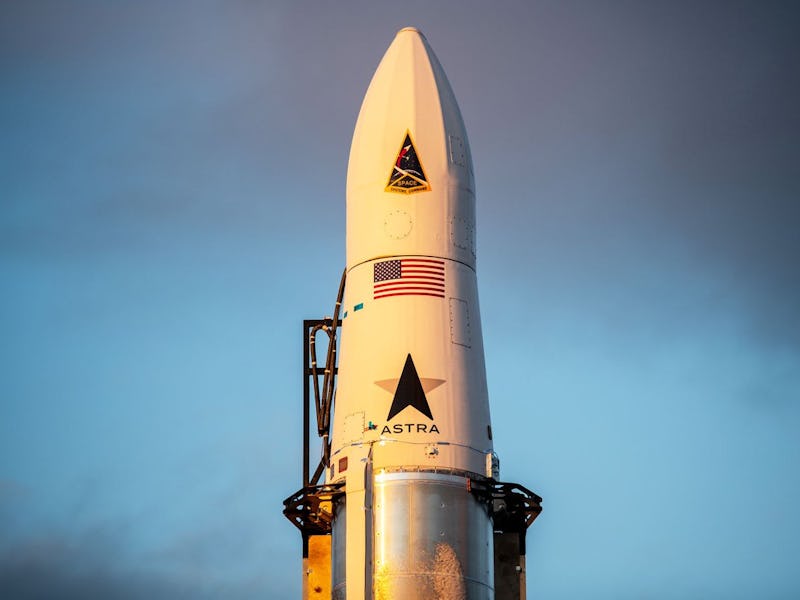Look: Awe-inspiring video shows the “FedEx of Space” reach orbit
The feat drew the attention of Musk.

An elusive, California-based spaceflight company is the latest to successfully reach orbit — and it plans to host daily flights in just four years.
On Saturday, Astra announced via Twitter that its LV0007 mission reached orbit from the Astra Spaceport in Kodiak, Alaska. The rocket, which carried a payload for the United States Space Force, took off at 1:16 a.m. Eastern time. The feat earned the praise of SpaceX CEO Elon Musk, who wrote on Twitter: “Congrats! Orbit is not easy.”
The milestone means Astra is one of a handful of private companies to successfully develop an orbital rocket. Following the launch Astra declared itself “the first rocket company to reach orbit in less than five years.”
The company was founded in 2016 and launched its first two rockets to suborbital space in 2018. Astra didn’t exit stealth mode until February 2020, and TechCrunch noted that it was referred to as “Stealth Space Company” before its big reveal.
Astra has big plans with its comparatively smaller rockets. CEO Chris Kemp told Space.com in July that the goal is to reach daily space launches by 2025.
Watch the launch below:
Here’s what to know about the milestone.
Want to find out more about competitors to SpaceX? Subscribe to MUSK READS+ for exclusive interviews and analysis about all things Musk.
Astra: What happened with LV0007 launch?
On October 12, Astra announced that it would launch a payload for the United States Space Force. The mission is dubbed LV0007. The mission would be the Space Test Program’s second mission with the company, dubbed STP-27AD2. The rocket carried a dummy test payload.
The launch took place at the Astra Spaceport in Kodiak, Alaska. It was originally scheduled to launch the previous day, but the countdown clock was paused at 13 minutes and 47 seconds prior to liftoff.
The rocket sent the test payload to an inclination of 86 degrees. It reached an altitude of 500 kilometers, or 310 miles.
This was Astra’s fourth attempt to reach orbit. Elon Musk, whose spaceflight firm SpaceX also reached orbit on the fourth attempt back in 2008, praised the team in the aftermath:
“Congrats! Orbit is not easy.”
Astra's orbital launch attempt for its Rocket 3.2 in December 2020.
Astra: What is the secretive orbital company?
Astra detailed its business plan when it exited stealth mode in February 2020. In a Bloomberg Businessweek article, co-founders Adam London and Chris Kemp explained how they want to build smaller, cheaper rockets at high speed. The company raised over $100 million from investors like Airbus Ventures and Salesforce co-founder Marc Benioff.
The plan is to launch satellites for just $1 million per launch. That’s a similar price to SpaceX’s SmallSat ride-share program, but as the name suggests, SpaceX’s offering requires users to commit to a schedule with other payloads.
A hotfire test of the Delphin first stage engine.
The company’s Rocket 3.3 vehicle is designed to launch payloads of up to 630 kg (1,390 pounds) to low-Earth orbit. That’s a lot smaller than SpaceX’s Falcon 9, which can send 22,800 kg (50,265 pounds) to the same orbit, and is closer to Rocket Lab’s small satellite-focused Electron rocket that can carry 300 kg (661 pounds) to low-Earth orbit.
The company is aiming for lots of small launches regularly. CEO Chris Kemp told Space.com in July that the plan is to gradually ramp up to monthly, then weekly launches, over the coming years. It will then aim for "daily space delivery, or roughly 300 launches, in 2025."
Thomas Burghardt, who hosted the latest flight’s livestream for NASASpaceflight, explained during the stream that Astra is aiming for more of like a FedEx service.
“You take a package to UPS or FedEx or something, and you say I need this to go someplace,” he said. “They don't schedule a flight right then and there, they already have flights scheduled. It's just a matter of putting payloads on board.”
With the successful first mission, that dream just came a step closer.
SUBSCRIBE TO MUSK READS+, A PREMIUM NEWSLETTER THAT COVERS THE WORLDS OF ELON MUSK, SPACEX, TESLA, AND EVERYTHING BETWEEN.
This article was originally published on